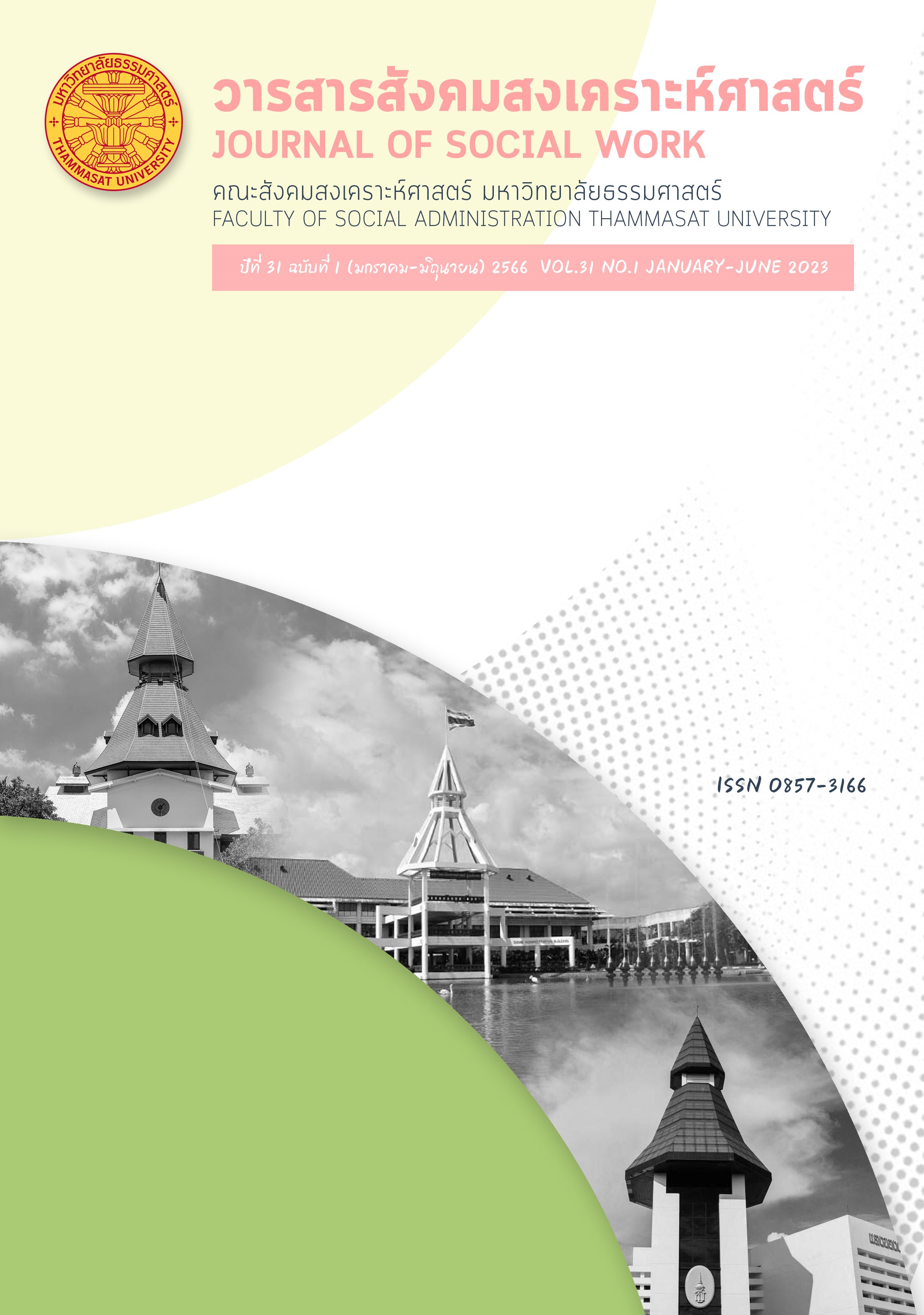“Online Vigilantism”: Violence, Power and Conflict
Keywords:
Vigilantism, Online vigilantismAbstract
This article aims to create knowledge about “Online Vigilantism”, drawing on information from studying conventional vigilantism, which then expands into online vigilantism. The Internet is an important tool which allows vigilantism to evolve into online spaces. Online vigilantism can be divided into 3 categories: 1. Real-life offences attracting online opprobrium 2. Online offences attracting online opprobrium, and 3. Real-life crime being investigated online. There are 4 types of online vigilantism according to degrees of violence: flagging, investigating, hounding, and organized leaking. Thus, online vigilantism covers most internet user behavior. This article focuses on the macro perspective of violence, power and conflict. The research led the author to conclude that online vigilantism can be perceived as invisible violence of a symbolic nature or cultural violence, one dimension power and reflects the basis of conflict. This signifies that if injustice or wrongdoings happen online, conflict and different perceptions will occur. Social media becomes a tool to stop these behaviors. However, this study concludes that, while the violators always claim freedom of opinion and expression to counter the argument, all internet usage should be within the boundary of basic human rights and respect for other people rights should always be considered.
References
ข่าวสด. (2564). ศาลสูงสุดสหรัฐ รับคำอุทธรณ์คดีระเบิดบอสตัน ลุ้นมือบึ้มรับ “โทษตาย” ตามเดิม, 13 กันยายน 2565. https://www.khaosod.co.th/around-the-world-news/news_6183101
คมชัดลึกออนไลน์. (2562). แพรวา เปลี่ยนชื่อเป็น บัวบูชา แต่งงานแล้วกับอดีตบิ๊กขรก, 13 กันยายน 2565. https://www.komchadluek.net/clip-vdo/379892
จารุวรรณ แก้วมะโน. (2551). วาทกรรม “ชาวบ้าน” กับการจำกัดตนเองในการมีส่วนร่วมทางการเมือง, ปริญญาดุษฎีบัณฑิต. จุฬาลงกรณ์มหาวิทยาลัย. กรุงเทพ
ไทยรัฐออนไลน์. (2565). นักสืบโซเชียล, 13 กันยายน 2565. https://www.thairath.co.th/news/local/2333910
ไทยไพส. (2564). อัยการสั่งไม่ฟ้องแอดมินเพจ'CSI LA'กับพวก! คดีแชร์ข้อมูลแหม่มถูกข่มขืนเกาะเต่า, 13 กันยายน 2565. https://www.thaipost.net/main/detail/106970
นิเวศน์ เหมวชิรวรากร . (2563) . ทัวร์ลง: ดร.นิเวศน์ เหมวชิรวรากร, 6 กันยายน 2565. https://www.efinancethai.com/MoneyStrategist/MoneyStrategistMain.aspx?id=ellGbERTUm11TzA9
ปิ่นบุญญา ลำมะนา. (2017). การจำกัดเสรีภาพในการแสดงความคิดเห็นและการแสดงออกในประเทศไทย. วารสารสังคมศาสตร์ นิติรัฐศาสตร์, 1(2),63-81.
ผู้จัดการออนไลน์ . (2563). กูรูสื่อเชียร์ “ม้า-อรนภา” ให้ยืนหยัดแม้ทัวร์ลง เพื่อเสรีภาพทางการเมืองคนบันเทิง!!, 6 กันยายน 2565. https://mgronline.com/live/detail/9630000087284
พรชัย ขันตี, กฤษณพงค์ พูตระกูล, และจอมเดช ตรีเมฆ. (2558). ทฤษฎีอาชญาวิทยา: หลักการ งานวิจัย และนโยบายประยุกต์. กรุงเทพมหานคร : สำนักพิมพ์มหาวิทยาลัยรังสิต.
พิรงรอง รามสูต, พิมลพรรณ ไชยนันท์, และ วิโรจน์ สุทธิสีมา. (2022). ห้องแห่งเสียงสะท้อนออนไลน์กับผู้ออกเสียง เลือกตั้งครั้งแรกในการเลือกตั้งทั่วไป พ.ศ.2562. วารสารสังคมศาสตร์, 52(2), 7-32.
MGR Online. (2557) . “คดีเกาะเต่า” ยิ่งสืบยิ่งเละ! ชาวเน็ตถล่ม จัดฉากดีเอ็นเอ!!?, 13 กันยายน 2565. https://mgronline.com/live/detail/9570000124685
Slang.in.th. (2019). ทัวร์ลง, 6 กันยายน 2565. https://slang.in.th/term/ทัวร์ลง
The Matter. (2019). คดีแพรวา: อุบัติเหตุ ความสูญเสีย การชดใช้ และการสำนึกผิด, 13 กันยายน 2565. https://thematter.co/social/praewa-case-lost-compensate-and-regret/80914
The Matter. (2019). 9 เรื่องควรรู้ 9 ปี คดีแพรวา ที่ผู้สูญเสียยังไม่ได้รับการชดเชย, 13 กันยายน 2565. https://thematter.co/social/9-years-praewa-case/80731
Abrahams, R. G. (1998). Vigilant citizens: Vigilantism and the state. Cambridge: Polity Press.
Bateson, R. (2021). The politics of vigilantism. Comparative Political Studies, 54(6), 923-955.
Brown, R. M. (1963). The South Carolina Regulators. Cambridge, Mass.: Bellnap Press of Harvard University Press.
Brown, R. M. (Ed.). (1970). American Violence (Vol. 231). New Jersey: Prentice Hall.
Brown, R. M. (1975). Strain of violence: Historical studies of American violence and vigilantism. Oxford: Oxford University Press.
Culberson, W. C. (1990). Vigilantism: Political history of private power in America (No. 28). California: Greenwood Publishing Group.
Galtung, J. (1990). Cultural violence. Journal of peace research, 27(3), 291-305.
Gerring, J. (1999). What makes a concept good? A criterial framework for understanding concept formation in the social sciences. Polity, 31(3), 357-393.
Graham, H. D., & Gurr, T. R. (1969). Violence in America: Historical and Comparative Perspectives: Dynamics of black and white violence (Vol. 1). US Government Printing Office.
Johnston, L. (1996). What is vigilantism?. The British Journal of Criminology, 36(2), 220-236.
Loveluck, B. (2020). The many shades of digital vigilantism. A typology of online self-justice. Global Crime, 21(3-4), 213-241.
Madison, A. (1973). Vigilantism in America. New York: Seabury Press.
Martin, J. (2009). Social Structures. Princeton: Princeton University Press.
Merriam-Webster. (2020). What It Means to Get 'Canceled' Show’s over, folks. Time to go home. Retrieved September 6, 2022, from https://www.merriam-webster.com/words-at-play/cancel-culture-words-were-watching#:~:text=The%20Origin%20of%20%27Cancel%20Culture%27%20The%20idea%20of,where%20it%20has%20been%20used%20as%20a%20hashtag.6
Mortensen, E. W. (2021). Justice Doers: The Vigilante as a Mythic Figure and its Role in Creating a More Violent Culture in America. York: York University.
Nhan, J., Huey, L., & Broll, R. (2017). Digilantism: An analysis of crowdsourcing and the Boston Marathon bombings. British Journal of Criminology, 57(2), 341–361.
Ossei-Owusu, S. (2020). Kangaroo Courts. Harv. L. Rev. F., 134, 200.
Powell, A., Stratton, G., & Cameron, R. (2018). Digital criminology: Crime and justice in digital society. Routledge.
Reichl, F. (2019). From vigilantism to digilantism?. In Social Media Strategy in Policing (pp. 117-138). Cham: Springer.
Rosenbaum, H. J., & Sederberg, P. C. (1974). Vigilantism: An analysis of establishment violence. Comparative Politics, 6(4), 541-570.
Smallridge, J., Wagner, P., & Crowl, J. N. (2016). Understanding cyber-vigilantism: A conceptual framework. Journal of Theoretical & Philosophical Criminology, 8(1).
Smallridge, J., & Wagner, P. (2020). The rise of online vigilantism. In The Palgrave Handbook of International Cybercrime and Cyberdeviance (pp. 1307-1331). Cham: Palgrave Macmillan.
Transcend.org. (2020). Varieties of Violence: Structural, Cultural, and Direct. Retrieved September 31, 2022, from https://www.transcend.org/tms/2020/01/varieties-of-violence-structural-cultural-and-direct-2/
Trottier, D. (2017). Digital vigilantism as weaponization of visibility. Philosophy & Technology, 30(1), 55-72.
Downloads
Published
How to Cite
Issue
Section
License
Copyright (c) 2023 Journal of Social Work

This work is licensed under a Creative Commons Attribution-NonCommercial-NoDerivatives 4.0 International License.
The manuscripts published in the Social Work Journal is the copyright of the Social Work Journal, Thammasat University
Any article or opinion appeared in the Social Work Journal will solely be under the responsibility of the author The Faculty of Social Administration, Thammasat University and the editors do not need to reach in agreement or hold any responsibility.



